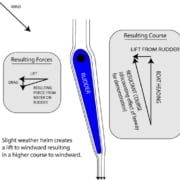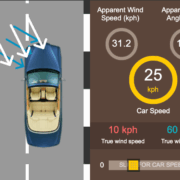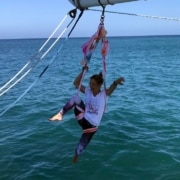Weather Helm Versus Lee Helm
What are they and what’s the difference? These two terms were established when vessels were fitted with tillers rather than wheels and so the term weather helm refers to having to pull the tiller (helm) “to weather” in order to sail in a straight line. Lee helm is when you need to push the tiller (helm) “to lee” in order to sail in a straight line.
Pulling the tiller to weather (or towards the windwind side of the boat) means that the boat left by it self would tend to turn into the wind. And conversely, lee helm would mean that the boat wants to turn down wind.
Now on a sailboat with a wheel, weather helm is turning the wheel away from the wind and lee helm is turning the wheel to helm in order to hold a straight course. This is because the wheel is opposite the rudder. Don’t get confused here – if you have to go back to fundamentals to work it out each time then just remember that sailing was invented thousand of years ago before the put wheels on boat. “Weather helm is rudder to weather”.
These phenomenons can be fixed quite simply by tilting (raking) the mast forward or aft. To reduce weather helm you’d want the center of pressure of the wind acting on the sail to move forward on the boat. See my last blog on how that works using the floating coke bottle. To reduce lee helm you’d rake the mast backwards.
There are also other things you can do to the sails which are quite detailed in the NauticEd SailTrim Course.
One might assume that you’d want a perfectly balanced boat with out any helm at all. Well that’s not quite true.
The first reason that is most often quoted is that weather helm is for safety. Let go the helm and the boat rounds up into the wind. That’s safer than having the boat bare away and speed away from you while you’re laying in the water.
However, the second reason is slightly more subtle yet makes a large difference to your performance. For the tiller to be pulled to weather (to the windward side of the boat) the rudder underneath is turned so that it also is pointing towards the wind. This angle creates a force from the water and the direction is to wards the windward side of the boat as well. This gives the boat “lift” to windward from underneath and guess what that does! It helps you win races.






